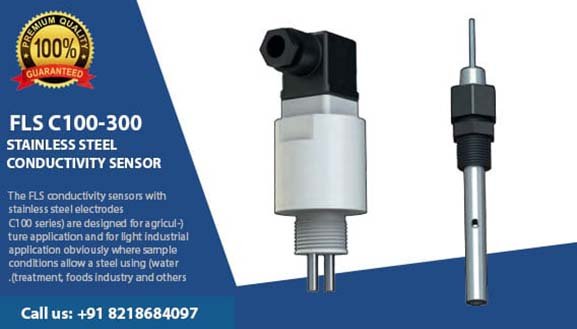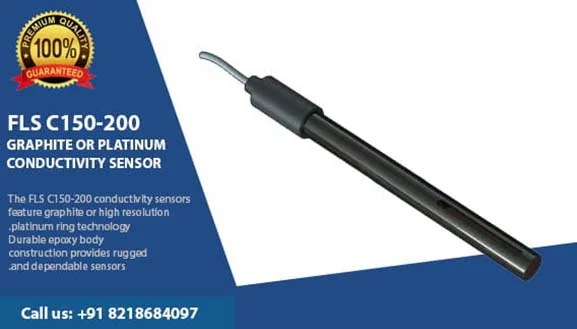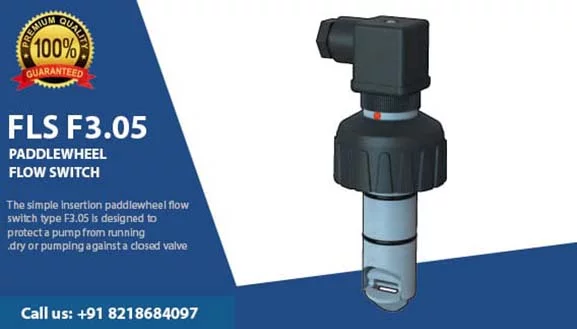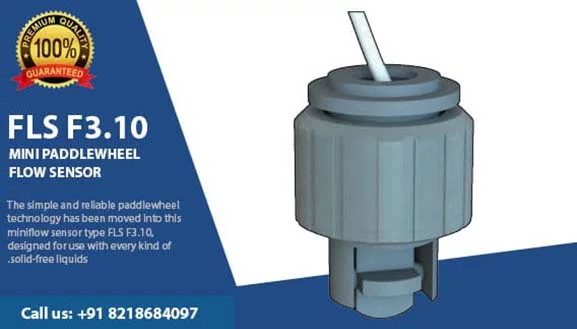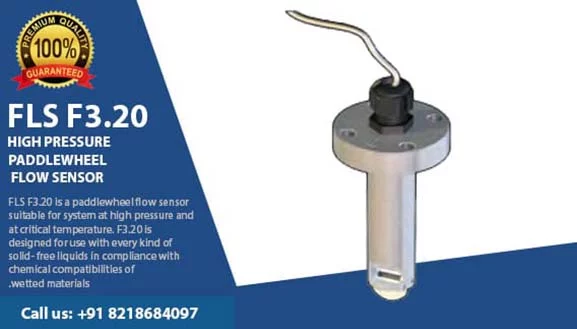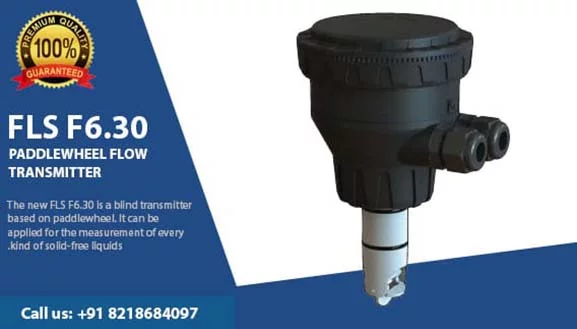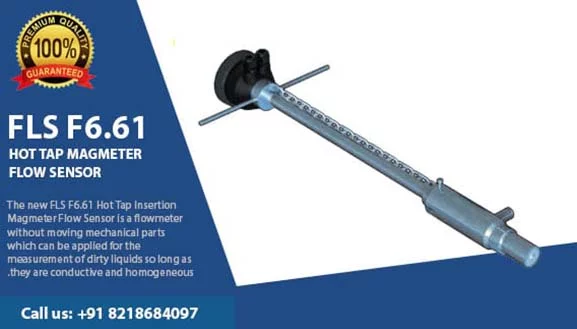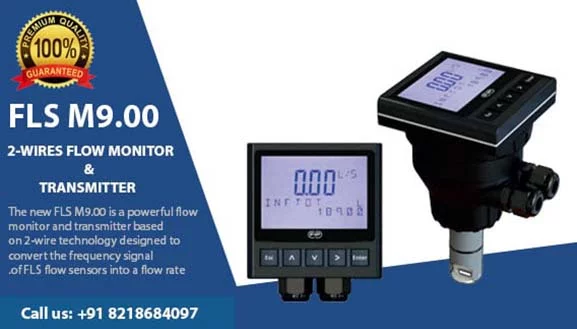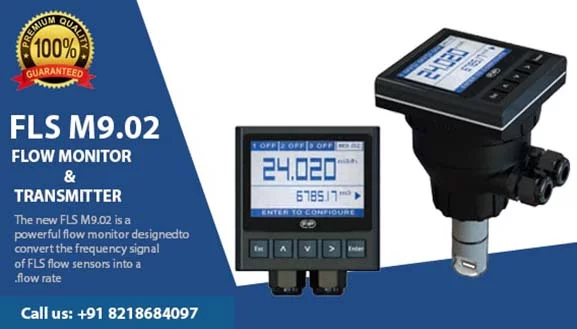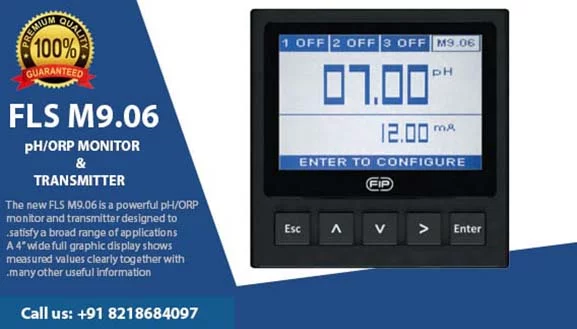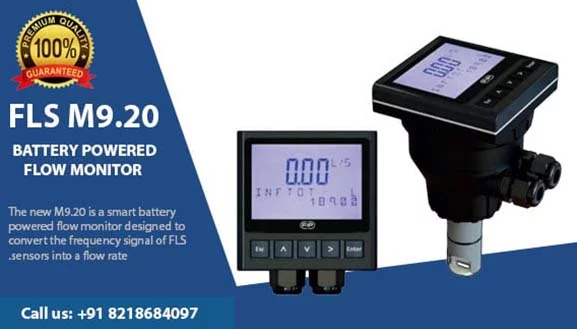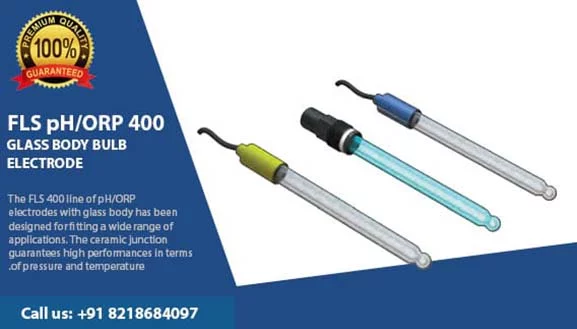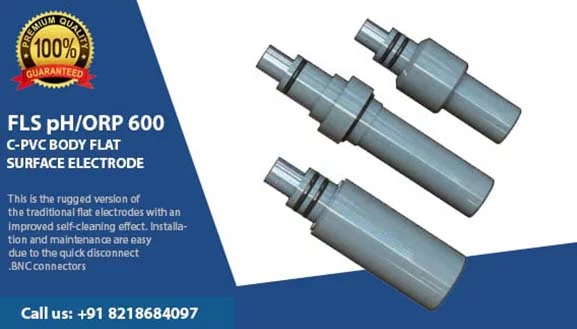Flow Meter Manufacturer
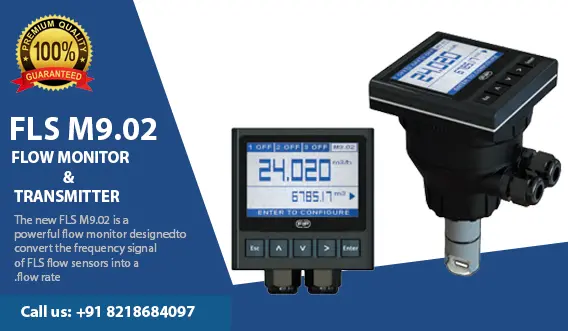
Flow Meter Manufacturer in India – FLOW MONITOR & TRANSMITTER-FLS M9.02
The new FLS M9.02 is a powerful flow monitor designed to convert the frequency signal of FLS flow sensors into a flow rate. M9.02 is equipped with a wide full graphic display4” which shows measured values clearly and a lot of other useful information. Moreover, due to a multicolour display plus a powerful backlight, measurement status can be determined easily from afar also. A tutorial software guarantees a mistake-proof and fast set up of every parameter. Calibration can be performed just fixing installation features or using a reference value through a new “in-line calibration”. A 4-20mAoutput is available to remote flow rate to a external device. A proper combination of digital outputs allows customized setups for any process to be controlled. The USB port on the rear part allows the upgrade of software offering a wide range of customization services both standard and on request. We are the best flow meter manufacturer in India and UAE also.
Flow Measurement System
Flow Measurement System
High-Quality Flow Meter Manufacturer | Petron Thermoplast
Petron Thermoplast is a leading flow meter manufacturer, providing high-quality flow meters for a wide range of industrial applications. We take pride in our commitment to delivering accurate and reliable solutions to meet our clients’ unique needs.
Our flow meters are manufactured using state-of-the-art technology and top-quality materials to ensure superior performance and durability. We offer a wide range of flow meters, including electromagnetic flow meters, ultrasonic flow meters, vortex flow meters, and more.
As a trusted flow meter manufacturer, we understand the importance of providing customizable solutions to meet our clients’ specific requirements. Our team of experts works closely with clients to design and manufacture flow meters that deliver accurate measurements and meet the demands of their applications.
Whether you need flow meters for the pharmaceutical, chemical, or food and beverage industry, Petron Thermoplast has got you covered. Our flow meters are engineered to meet the highest standards of quality and precision, ensuring accurate measurement and reliable performance.
APPLICATIONS OF FLOW METER
• Water treatment systems
• Industrial waste water treatment and recovery
• Water distribution
• Filtration systems
• Swimming pools & SPA
• Irrigation & Fertigation
• Leak detection
• Cooling water monitoring
• Processing and manufacturing industry
• Chemical production
MAIN FEATURES OF FLOW METER
• Wide full graphic display
• Multicolor backlight
• Help on board
• Installation flexibility
• Fast, intuitive and mistake-proof calibration software
• Mechanical relay for external device control
• Solid State Relays for programmable alarms
• Multilanguage menu
• USB port for software upgrading
Technical Data
General
• Associated sensors: FLS hall effect flow sensors with
frequency output or FLS F6.60 Flow sensor magmeters
• Materials:
– Case: ABS
– Display window: PC
– Panel & Wall gasket: silicone rubber
– Keypad: 5-button silicone rubber
• Display:
– LC full graphic display
– Backlight version: 3-colours
– Backlight activation: User adjustable with 5 levels of
timing
– Update rate: 1 second
– Enclosure: IP65 front
• Flow input range (frequency): 0÷1500Hz
• Flow input accuracy (frequency): 0,5%
Electrical
• Supply Voltage: 12 to 24 VDC ± 10% regulated
• Max Power Consumption: < 200 mA
• FLS hall effect flow Sensor power:
– 5 VDC @ < 20 mA
– Optically isolated from current loop
– Short circuit protected
• 1*Current output:
– 4-20 mA, isolated, fully adjustable and reversible
– Max loop impedance: 800 Ω @ 24 VDC – 250 Ω @
12 VDC
• 2*Solid State Relay output:
– User selectable as MIN alarm, MAX alarm, Pulse
Out, Window alarm, Off
– Optically isolated, 50 mA MAX sink, 24 VDC MAX
pull-up voltage
– Max pulse/min: 300
– Hysteresis: User selectable
• 1*Relay output:
– User selectable as MIN alarm, MAX alarm, Pulse
Out, Window alarm, Off
– Mechanical SPDT contact
– Expected mechanical life (min. operations): 107
– Expected electrical life (min. operations): 105 N.O./
N.C.switching capacity 5A/240VAC
– Max pulse/min: 60
– Hysteresis: User selectable
Environmental
• Operating temperature: -10 to +70°C (+14 to +158 °F)
• Storage temperature: -30 to +80°C (-22 to +176 °F)
• Relative humidity: 0 to 95% not condensing
Standards & Approvals
• Manufactured under ISO 9001
• Manufactured under ISO 14001
• CE
• RoHS Compliant
• EAC
• FDA on request for paddlewheel in C-PVC/EPDM,
PVDF/EPDM, SS316L/EPDM.
WIRING CONNECTIONS
Rear Terminal View
M9.02 Flow Monitor and Transmitter
| Part No. | Description/Name | Power supply | Wire power Technology | Sensor Input | Output | Weight (gr.) |
|---|---|---|---|---|---|---|
| M9.02.P1 | Panel mount Flow monitor | 12 – 24 VDC | 3/4 wire | Flow (Frequency) | 1*(4-20mA) 2*(S.S.R.),1*(mech. relay) | 500 |
| M9.02.W1 | Wall mount Flow monitor | 12 – 24 VDC | 3/4 wire | Flow (Frequency) | 1*(4-20mA)< 2*(S.S.R.),1*(mech. relay) | 550 |
| M9.02.W2 | Wall mount Flow monitor | 110 – 230 VAC | 3/4 wire | Flow (Frequency) | 1*(4-20mA) 2*(S.S.R.),1*(mech. relay) | 650 |
M9.02 Flow Monitor and Transmitter Field mount
| Part No. | Description/Name | Power supply | Wire power Technology | Sensor Input | Output | Lenght | Main Wetted Materials | Weight (gr.) |
|---|---|---|---|---|---|---|---|---|
| M9.02.01 | Field mount Flow monitor | 12 – 24 VDC | 3/4 wire | Flow (Frequency) | 1*(4-20mA), 2*(S.S.R.), 1*(mech. relay) | L0 | C-PVC/EPDM | 550 |
| M9.02.02 | Field mount Flow monitor | 12 – 24 VDC | 3/4 wire | Flow (Frequency) | 1*(4-20mA), 2*(S.S.R.), 1*(mech. relay) | L0 | C-PVC/FPM | 550 |
| M9.02.03 | Field mount Flow monitor | 12 – 24 VDC | 3/4 wire | Flow (Frequency) | 1*(4-20mA), 2*(S.S.R.), 1*(mech. relay) | L1 | C-PVC/EPDM | 550 |
| M9.02.04 | Field mount Flow monitor | 12 – 24 VDC | 3/4 wire | Flow (Frequency) | 1*(4-20mA), 2*(S.S.R.), 1*(mech. relay) | L1 | C-PVC /FPM | 550 |
| M9.02.05 | Field mount Flow monitor | 12 – 24 VDC | 3/4 wire | Flow (Frequency) | 1*(4-20mA), 2*(S.S.R.), 1*(mech. relay) | L0 | PVDF/EPDM | 550 |
| M9.02.06 | Field mount Flow monitor | 12 – 24 VDC | 3/4 wire | Flow (Frequency) | 1*(4-20mA), 2*(S.S.R.), 1*(mech. relay) | L0 | PVDF/FPM | 550 |
| M9.02.07 | Field mount Flow monitor | 12 – 24 VDC | 3/4 wire | Flow (Frequency) | 1*(4-20mA), 2*(S.S.R.), 1*(mech. relay) | L1 | PVDF/EPDM | 550 |
| M9.02.08 | Field mount Flow monitor | 12 – 24 VDC | 3/4 wire | Flow (Frequency) | 1*(4-20mA), 2*(S.S.R.), 1*(mech. relay) | L1 | PVDF/FPM | 550 |
| M9.02.09 | Field mount Flow monitor | 12 – 24 VDC | 3/4 wire | Flow (Frequency) | 1*(4-20mA), 2*(S.S.R.), 1*(mech. Relay) | L0 | SS316L/EPDM | 600 |
| M9.02.10 | Field mount Flow monitor | 12 – 24 VDC | 3/4 wire | Flow (Frequency) | 1*(4-20mA), 2*(S.S.R.), 1*(mech. relay) | L0 | SS316L/FPM | 600 |
| M9.02.11 | Field mount Flow monitor | 12 – 24 VDC | 3/4 wire | Flow (Frequency) | 1*(4-20mA), 2*(S.S.R.), 1*(mech. relay) | L1 | SS316L/EPDM | 600 |
| M9.02.12 | Field mount Flow monitor | 12 – 24 VDC | 3/4 wire | Flow (Frequency) | 1*(4-20mA), 2*(S.S.R.), 1*(mech. relay) | L1 | SS316L/FPM | 600 |
GET THE LATEST Flow Meter Manufacturer PRICES ON YOUR EMAIL


